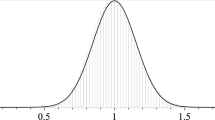Abstract
The proof of the asymptotic quadratic convergence is provided for the parallel two-sided block-Jacobi EVD algorithm with dynamic ordering for Hermitian matrices. The discussion covers the case of well-separated eigenvalues as well as clusters of eigenvalues. Having p processors, each parallel iteration step consists of zeroing 2p off-diagonal blocks chosen by dynamic ordering with the aim to maximize the decrease of the off-diagonal Frobenius norm. Numerical experiments illustrate and confirm the developed theory.




Similar content being viewed by others
References
Bečka, M., Vajteršic, M.: Block-Jacobi SVD algorithms for distributed memory systems I: hypercubes and rings. Parallel Algorithm Appl. 13, 265–287 (1999)
Bečka, M., Okša, G., Vajteršic, M.: Dynamic ordering for a parallel block-Jacobi SVD algorithm. Parallel Comput. 28, 243–262 (2002)
Bečka, M., Okša, G., Vajteršic, M.: New dynamic orderings for the parallel one-sided block-Jacobi SVD algorithm. Parallel Proc. Lett. (2015). https://doi.org/10.1142/S0129626415500036
Demmel, J.W., Veselić, K.: Jacobi’s method is more accurate than QR. SIAM J. Matrix Anal. Appl. 13, 1204–1245 (1992)
Dopico, F.M., Molera, J.M., Moro, J.: An orthogonal high relative accuracy algorithm for symmetric eigenproblem. SIAM J. Matrix Anal. Appl. 25, 301–351 (2003)
Drmač, Z., Veselić, K.: New fast and accurate Jacobi SVD algorithm: I. SIAM J. Matrix Anal. Appl. 29, 1322–1342 (2007)
Drmač, Z., Veselić, K.: New fast and accurate Jacobi SVD algorithm: II. SIAM J. Matrix Anal. Appl. 29, 1343–1362 (2007)
Drmač, Z.: A global convergence proof for cyclic Jacobi methods with block rotations. SIAM J. Matrix Anal. Appl. 31, 1329–1350 (2010)
Golub, G.H., Van Loan, C.F.: Matrix Computations, 4th edn. Johns Hopkins UP, Baltimore (2013)
Hari, V.: On sharp quadratic convergence bounds for the serial Jacobi methods. Numer. Math. 60, 375–406 (1991)
Hari, V.: Convergence to diagonal form of block Jacobi-type methods. Numer. Math. 129, 449–481 (2015)
Hoffman, A.J., Wielandt, H.W.: The variation of the spectrum of a normal matrix. Duke Math. J. 20, 37–39 (1953)
Kudo, S., Yamamoto, Y., Bečka, M., Vajteršic, M.: Performance analysis and optimization of the parallel one-sided block-Jacobi SVD algorithm with dynamic ordering and variable blocking. Concurrency and Computation: Practice and Experience (2016). https://doi.org/10.1002/cpe.4059
Luk, F., Park, H.: On parallel Jacobi orderings. SIAM J. Sci. Stat. Comput. 10, 18–26 (1989)
Luk, F., Park, H.: A proof of convergence for two parallel Jacobi SVD algorithms. IEE Trans. Comp. 38, 806–811 (1989)
Matejaš, J., Hari, V.: Accuracy of the Kogbetliantz method for the scaled diagonally dominant triangular matrices. Appl. Math. Comput. 217, 3726–3746 (2010)
Mathias, R.: Accurate eigensystem computations by Jacobi methods. SIAM J. Matrix Anal. Appl. 16, 977–1003 (1995)
Okša, G., Vajteršic, M.: Efficient pre-processing in the parallel block-Jacobi SVD algorithm. Parallel Comput. 32, 166–176 (2006)
Okša, G., Yamamoto, Y., Vajteršic, M.: Asymptotic quadratic convergence of the serial block-Jacobi EVD algorithm for Hermitian matrices. Numer. Math. 136, 1071–1095 (2017)
Parlett, B.N.: The Symmetric Eigenvalue Problem. SIAM, Philadelphia (1987)
Sameh, A.H.: On Jacobi and Jacobi-like algorithms for parallel computer. Math. Comput. 25, 579–590 (1971)
Schönhage, A.: Zur Konvergenz des Jacobi-Verfahrens. Numer. Math 3, 374–380 (1961)
Schönhage, A.: Zur quadratischen Konvergenz des Jacobi-Verfahrens. Numer. Math. 6, 410–412 (1964)
Shroff, G., Schreiber, R.: On the convergence of the cyclic Jacobi method for parallel block orderings. SIAM J. Matrix Anal. Appl. 10, 326–346 (1989)
Yamamoto, Y., Lan, Z., Kudo, S.: Convergence analysis of the parallel classical block Jacobi method for the symmetric eigenvalue problem. J. SIAM Lett. 6, 57–60 (2014)
Zhou, B.B., Brent, R.P.: Jacobi-like algorithms for eigenvalue decomposition of a real normal matrix using real arithmetic. In: Proceedings of IPPS’96, the 10th International Parallel Processing Symposium, 15–19 April, Honolulu, Hawai, USA (1996)
Acknowledgements
We thank both anonymous referees for their comments and suggestions that significantly improved the paper’s quality.
Author information
Authors and Affiliations
Corresponding author
Additional information
Communicated by Daniel Kressner.
Gabriel Okša, Martin Bečka and Marián Vajteršic were supported by the VEGA Grant No. 2/0004/17. Yusaku Yamamoto was supported in part by the Japanese Ministry of Education, Science, Sports and Culture, Grant-in-Aid for Scientific Research (Nos. 26286087, 15H02708, 15H02709, 16KT0016, 17H02828, 17K19966).
Proof of Lemma 1
Proof of Lemma 1
Proof
The proof of Eq. (6) is similar to the proof of Lemma 1 in [19]. The left-hand side of Eq. (6) is bounded by an intermediate quantity involving \(\Vert A_{X_i X_j}\Vert _F\), \(\Vert A_{Y_i X_j}\Vert _F\) and \(\Vert P_{Y_i X_i}\Vert _2\) as follows (see [19, p. 1076]):
Then Eq. (6) follows immediately by using \(\max \left\{ \Vert A_{X_i X_j}\Vert _F^2,\Vert A_{Y_i X_j}\Vert _F^2\right\} \le \Vert A_{X_1 Y_1}\Vert _F^2\) and \(\Vert P_{Y_i X_i}\Vert _2 \le \Vert A_{X_i Y_i}\Vert _F/\delta \). Similarly, the left-hand side of Eq. (7) can be bounded as
To bound the right-hand side, we need to evaluate \(\Vert \tilde{A}_{X_i X_j}\Vert _F\) and \(\Vert \tilde{A}_{X_i Y_j}\Vert _F\). From the definition of \(\tilde{A}_{X_i X_j}\),
we have
On the other hand, from the unitarity of transformation in Eq. (3), we have
which leads to
Similarly,
Putting upper bounds from Eqs. (34) and (35) into the first term of Eq. (31), and inserting upper bounds from Eqs. (33) and (35) into the second term of Eq. (31) gives
where we used the upper bound \(2ab\le a^2+b^2\) in the last inequality.
Since the row and column updates for remaining three off-diagonal blocks are, mutatis mutandis block indices, the same as for \(A_{X_iX_j}\) (see Eq. (5)), applying the above approach three times one gets remaining upper bounds for the changes of \(\Vert A_{X_iY_j}\Vert _F^2\), \(\Vert A_{Y_iX_j}\Vert _F^2\) and \(\Vert A_{Y_iY_j}\Vert _F^2\). \(\square \)
Rights and permissions
About this article
Cite this article
Okša, G., Yamamoto, Y., Bečka, M. et al. Asymptotic quadratic convergence of the parallel block-Jacobi EVD algorithm with dynamic ordering for Hermitian matrices. Bit Numer Math 58, 1099–1123 (2018). https://doi.org/10.1007/s10543-018-0711-3
Received:
Accepted:
Published:
Issue Date:
DOI: https://doi.org/10.1007/s10543-018-0711-3




